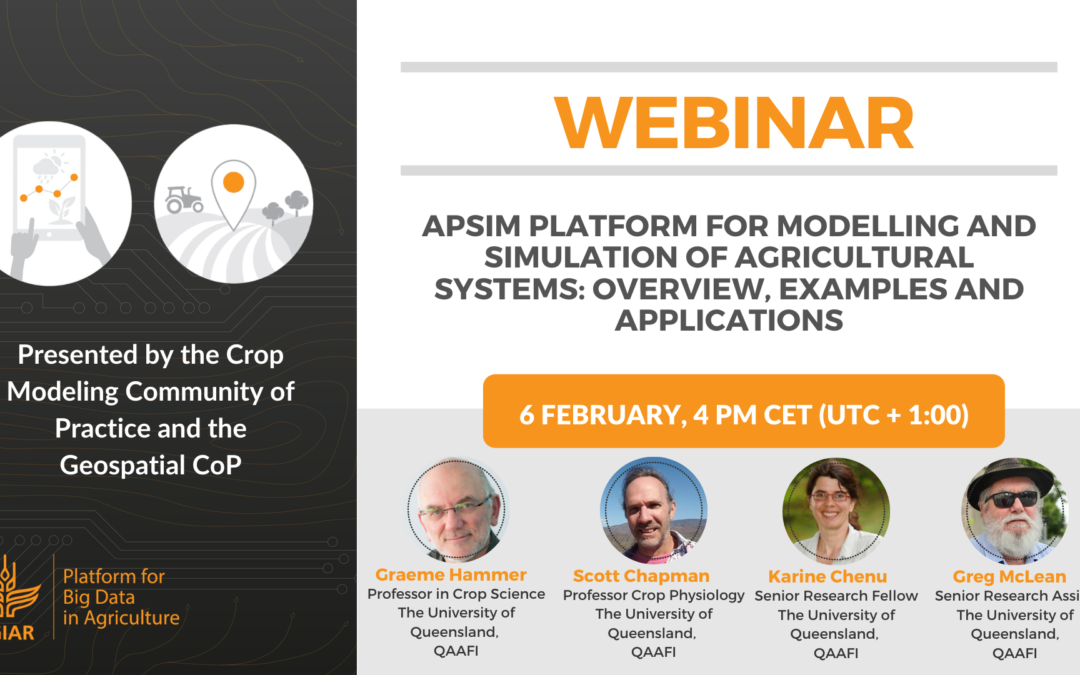Webinar – Overview, examples & applications of APSIM platform
Webinar organized by the Crop Modeling Community of Practice in collaboration with the Geospatial Community of Practice.
The Agricultural Production Systems sIMulator (APSIM) platform is widely used worldwide for modeling and simulation of agricultural systems. We held a webinar to give an overview and look at some examples & applications of the platform.
It contains a suite of modules that enable the simulation of systems for a diverse range of plant, animal, soil, climate, and management interactions. These modules include a diverse range of crops, pastures, trees, soil processes including water balance, N and P transformations, soil pH, erosion and a full range of management controls. APSIM resulted from a need for tools that provided accurate predictions of crop production in relation to climate, genotype, soil, and management factors while addressing the long-term resource management issues.
In this webinar, organized by the Crop Modeling Community of Practice in collaboration with the Geospatial Community of Practice, a panel of APSIM experts formed by Graeme Hammer, Scott Chapman, Greg McLean and Karine Chenu will present an overview of the platform, their experience, and some relevant examples. After their brief introduction, webinar attendees will have the opportunity to ask any APSIM-related questions.
Presenters
Graeme Hammer
Professor in Crop Science
Centre for Crop Science, Queensland Alliance for Agriculture and Food Innovation
The University of Queensland
Scott Chapman
Professor of Crop Physiology
Centre for Crop Science, Queensland Alliance for Agriculture and Food Innovation
The University of Queensland, The University of Queensland
Karine Chenu
Senior Research Fellow
Centre for Crop Science, Queensland Alliance for Agriculture and Food Innovation
The University of Queensland
Greg McLean
Senior Research Assistant
Centre for Crop Science, Queensland Alliance for Agriculture and Food Innovation
The University of Queensland
Follow on questions
We ran out of time to answer some of your questions during the webinar, but have done our best to answer them below. We have also included links to resources mentioned during the Q&A.
QUESTION: What is the progress of having APSIM simulate perennial agroforestry systems? Does APSIM has capabilities to simulate perennial cropping systems taking into account very deep rooting, absence of tillage, shading (tree of interest is shaded by other trees as in cocoa) and organic matter accumulation?
ANSWER: Yes, APSIM has modules for agro-forestry species that can be combined with crop species. Shading effects are accommodated mainly via impacts on radiation distribution in the different levels of a multi-species canopy. The APSIM manager language allows users to utilise experimental data to design new computations (e.g. effect of shading on growth temperatures of the under-story canopy) that could be expanded if not already in the model. Main APSIM contact for these systems is neil.huth@csiro.au.
Please see the webinar recording for a complete answer.
QUESTION: Oil palm related developments. New version source code available?
ANSWER: Contact neil.huth@csiro.au for the latest information on the oil palm module in APSIM.
QUESTION: Where can I download daily rainfall, max and min temperature?
ANSWER: NASA-Power provides some useful global datasets https://power.larc.nasa.gov/common/php/POWER_AboutAgroclimatology.php
Please see the webinar recording for a complete answer
QUESTION: Does APSIM simulate the effect of ion toxicity on crop production, if yes, is it applied for all crop types in APSIM?
ANSWER: No.
QUESTION: Are there ways of leveraging APSIM functionality via R, rather than using the software UI?
ANSWER: APSIM can be executed directly from the command line or via other programs. There are several packages for interacting with APSIM via R. Can contact APSIM support for further information: apsim@csiro.au. Please see the webinar recording for a complete answer
QUESTION: I was wondering if APSIM takes away from the high cost of running provenance testing.
ANSWER: Modeling alone cannot replace field testing.
QUESTION: Is there any training going to happen soon to automatize APSIM to run for a large area comprising several grids such as the entirety of Africa?
ANSWER: APSIM has already been run across weather and soil grids in Australia and this could be done elsewhere with available input data if the model has been suitably tested for the environments and management systems involved.
QUESTION: For any given geography – with specific crops and associated data sets, what is the average accuracy level associated?
ANSWER: Model tests often give R2 values around 80% for predicted vs observed biomass and yield data across diverse situations – there are a number of papers showing tests for various crops
QUESTION: I have a problem to collect data in my country, it is not easy to access to the data and also there is not enough information. There is any possibility to estimate these data, or there is a website that can give us an idea on crops, climate … etc.
ANSWER: Real data is required for testing crop models to support their credible use in new locations
QUESTION: You mentioned APSIM can be used in agroforestry. Could you please briefly explain how to simulate different of incident radiation received by crop and tree?
ANSWER: Best to go and find the papers on this: Eg Huth, N.I., et al 2002. A framework for simulating agroforestry options for the low rainfall areas of Australia using APSIM. Eur. J. Agron. 18.
QUESTION: In the case of Tunisia, which dataset do you use to estimate the dose of irrigation?
ANSWER: Irrigation amounts need to be measured in specific experiments
QUESTION: How to get the version of APSIM available without the windows interface for compiling it in console mode and spatially explicit running? Ajit Govind, ICARDA
ANSWER: It is provided with the download. Refer to www.apsim.info and the support pages for more information.
February 26, 2020









